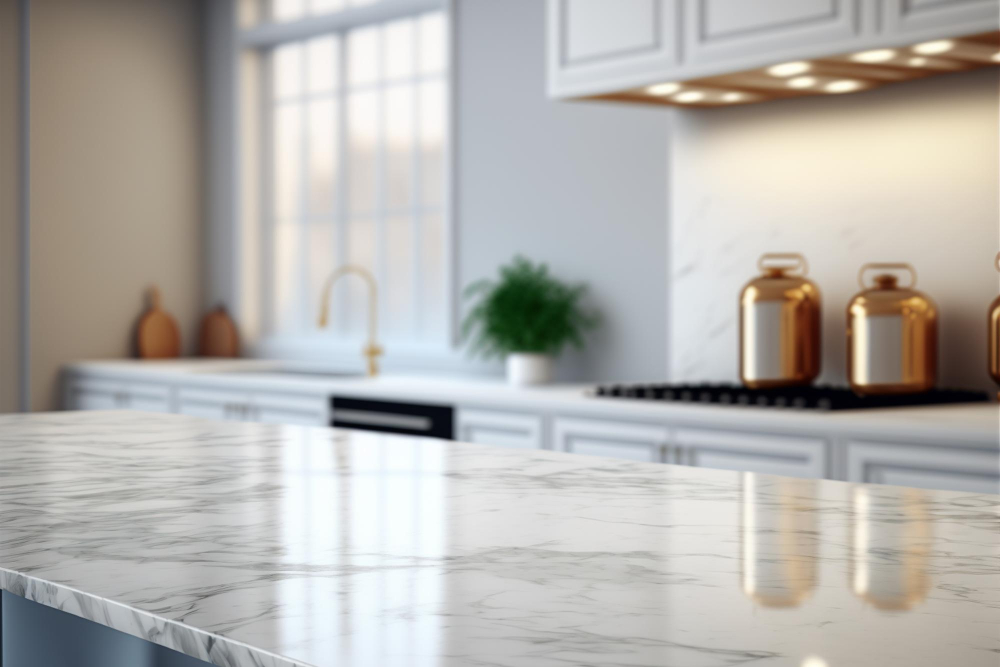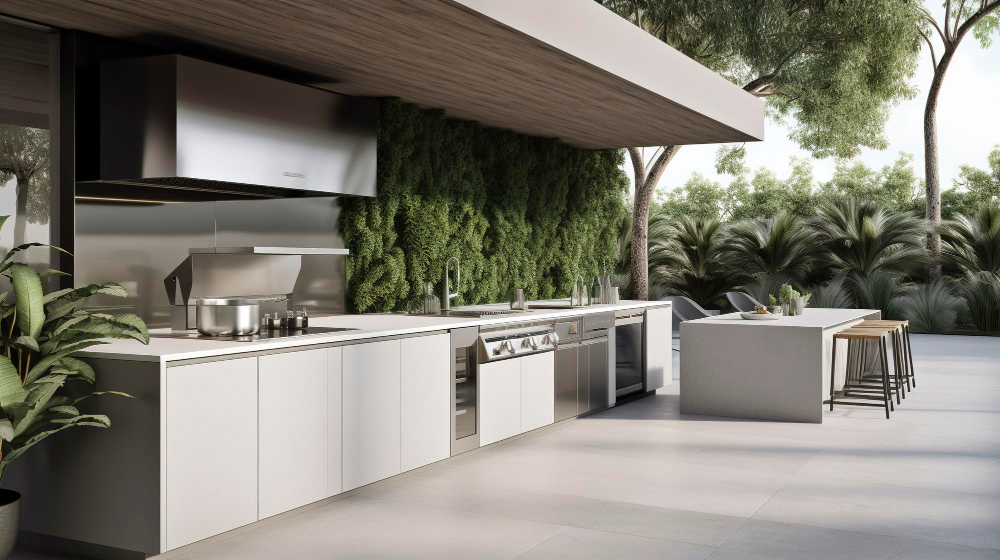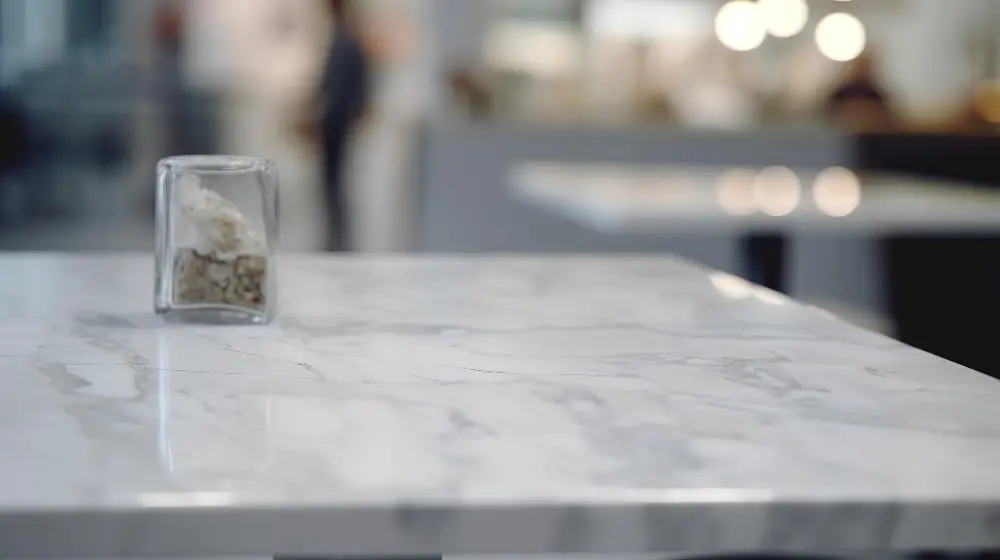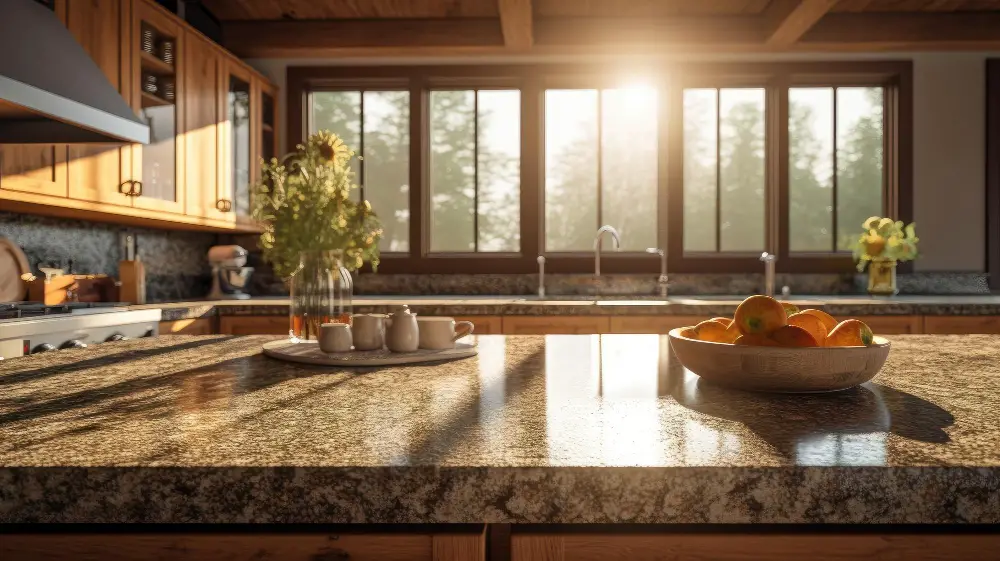Last updated on
Discover the benefits and drawbacks of using quartzite in your outdoor kitchen, helping you make an informed decision for your dream cooking space.
If you’re planning to create an outdoor kitchen, choosing the right materials is crucial. You want something that looks great, but also holds up against the elements and regular use.
While there are many options available, one material that often comes up in discussions is quartzite. But is it a good choice for an outdoor kitchen? In this article, we’ll explore the benefits and drawbacks of using quartzite for your outdoor cooking space so you can make an informed decision and create a stunning and durable area to entertain family and friends.
What's Inside
Quartzite Properties and Features
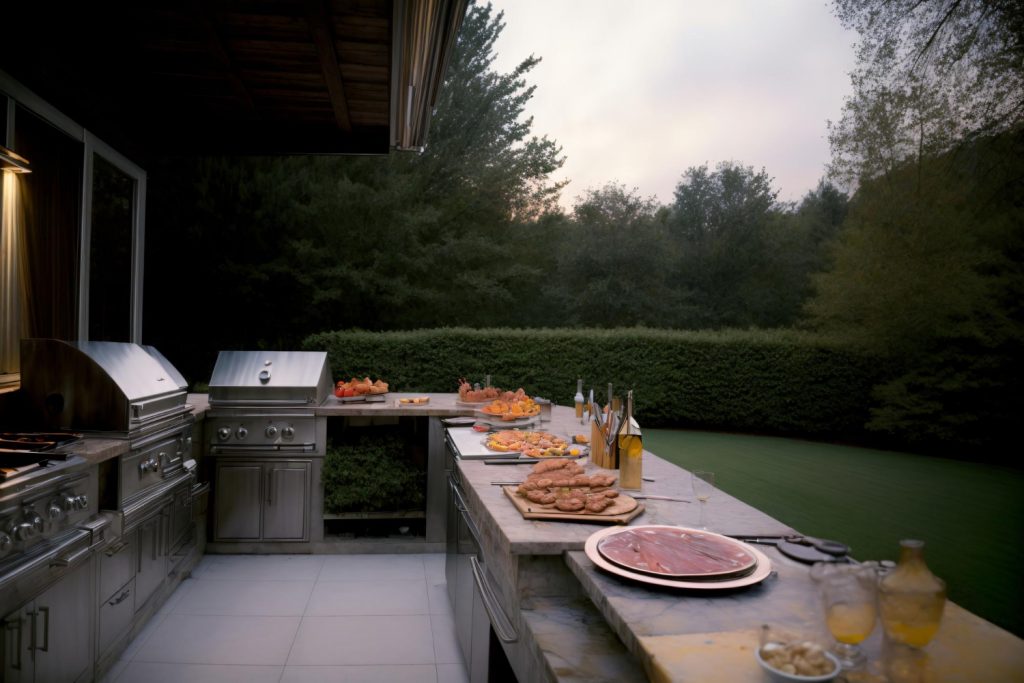
It’s an incredibly hard, durable material that can withstand the elements, making it ideal for outdoor kitchens. Quartzite has a unique texture with visible grains of quartz crystals throughout the surface, giving it a distinctive look that many homeowners love.
One of the most significant benefits of using quartzite in your outdoor kitchen is its resistance to scratches and stains. Unlike other materials like marble or granite, which are porous and prone to staining if not sealed properly, quartzite is non-porous by nature.
This means you won’t have to worry about spills or stains ruining your countertops during cooking sessions.
Another advantage of using this material in your outdoor kitchen design is its ability to handle extreme temperatures without cracking or fading over time. Whether you’re grilling up steaks on hot summer days or baking pizzas in an oven outdoors during winter months – Quartzite will hold up well against these conditions.
Quartzite Vs Quartz: Know the Difference
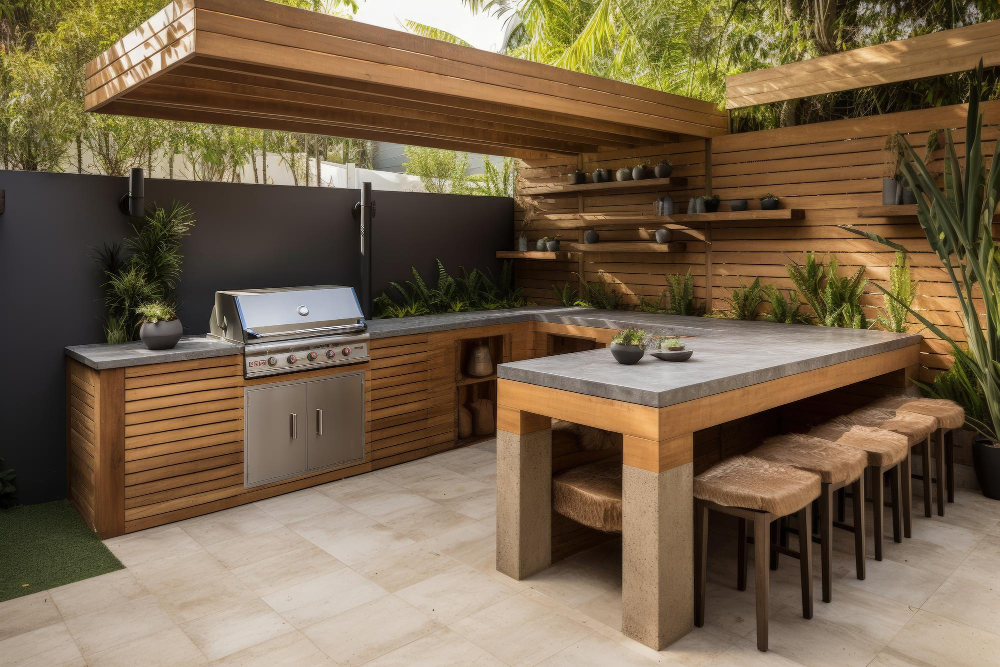
While these two materials sound similar, they are actually quite different in terms of their properties and features.
Quartz is a man-made material that is composed of ground-up natural stone mixed with resins, pigments, and other additives. It’s known for its durability and low maintenance requirements but can be prone to discoloration over time when exposed to direct sunlight.
On the other hand, quartzite is a naturally occurring metamorphic rock that forms from sandstone under high heat and pressure. It’s incredibly durable thanks to its dense composition but requires more maintenance than quartz due to its porous nature.
So which one should you choose? Ultimately it depends on your specific needs as well as personal preferences in terms of aesthetics.
Outdoor Kitchen: Setting the Scene
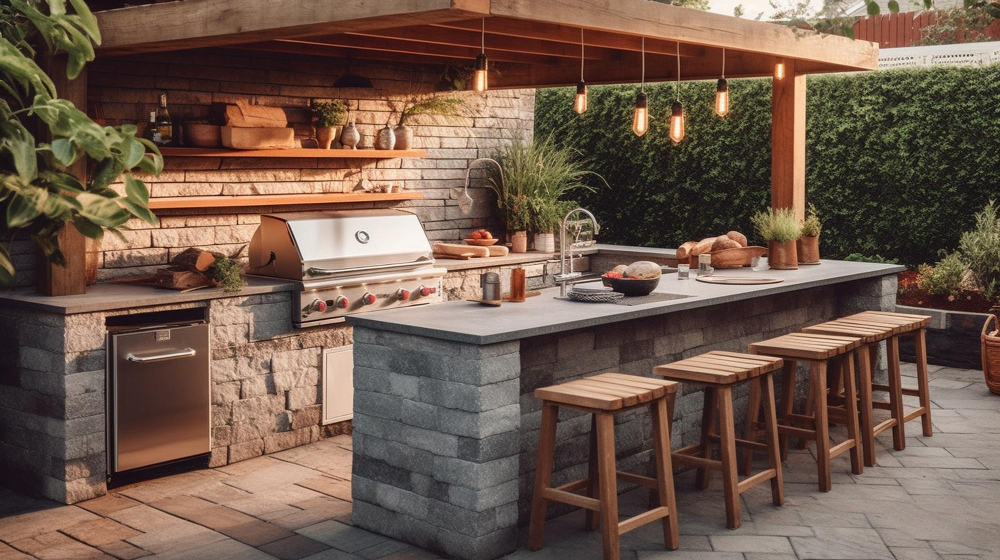
You want to create a space that’s not only functional but also inviting and comfortable for your guests. Consider factors such as lighting, seating arrangements, and landscaping when planning your outdoor kitchen area.
Lighting is crucial in any cooking space, especially outdoors where natural light may be limited or non-existent at night. Think about installing overhead lights above work areas and task lighting under cabinets or on countertops.
Seating arrangements are another essential aspect of creating an inviting atmosphere in your outdoor kitchen area. Whether you opt for bar stools at a countertop or lounge chairs around a fire pit, make sure there’s enough seating for everyone who will be using the space.
Don’t forget about landscaping! Adding plants and greenery can help soften hard edges while providing shade during hot summer days.
Benefits of Using Quartzite in Outdoor Kitchens
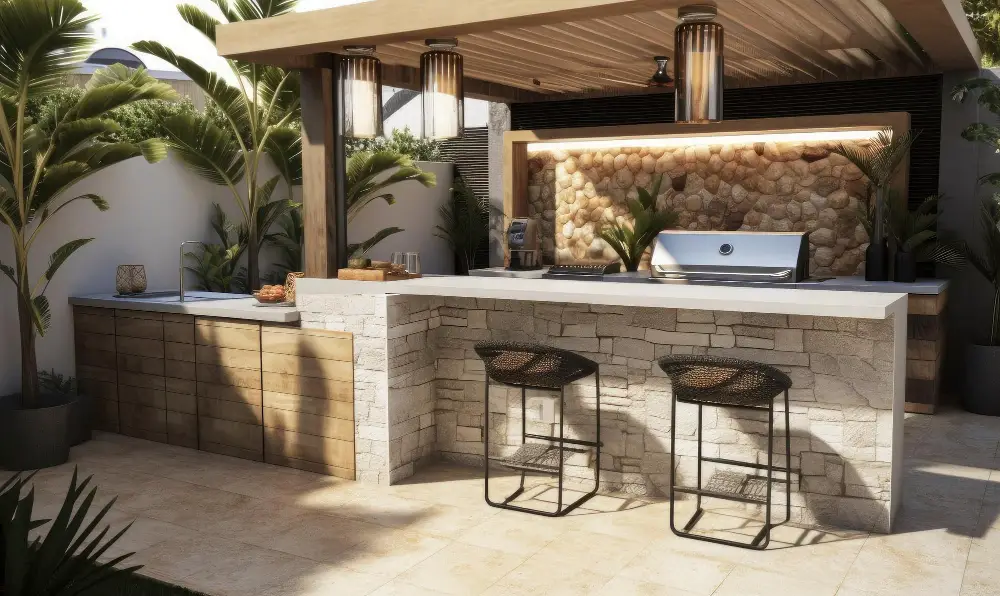
One of the most significant advantages of using quartzite in your outdoor kitchen is its durability and strength. Quartzite is an incredibly hard stone that can withstand heavy use, making it ideal for high-traffic areas like cooking spaces.
Another benefit of quartzite countertops in outdoor kitchens is their resistance to weathering. Unlike other natural stones, such as marble or limestone, which are prone to staining and etching from exposure to moisture and acidic substances, quartzite holds up well against the elements.
In addition to being durable and weather-resistant, quartzites come in a wide range of colors that can complement any design style you have envisioned for your dream cooking space. From classic white hues with subtle veining patterns reminiscent of marble slabs or bold black tones with striking veins running through them – there’s something available for every taste preference.
Weather Resistance of Quartzite
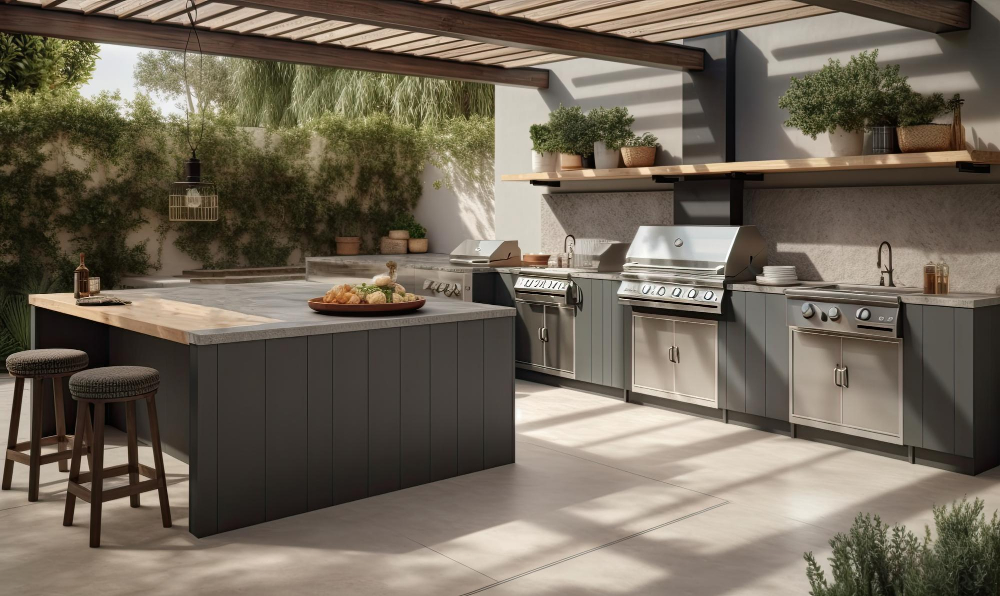
This process makes it an incredibly durable material, perfect for outdoor use. One of the most significant benefits of using quartzite in your outdoor kitchen is its weather resistance.
Unlike other materials like wood or concrete, which can crack or warp due to exposure to extreme temperatures, moisture, and UV rays over time; Quartzite holds up well against these elements. It’s resistant to water absorption and won’t freeze during winter months.
Quartzite doesn’t fade when exposed to sunlight as some synthetic materials do; this means you don’t have to worry about your countertops losing their color over time due to sun damage.
Durability and Strength
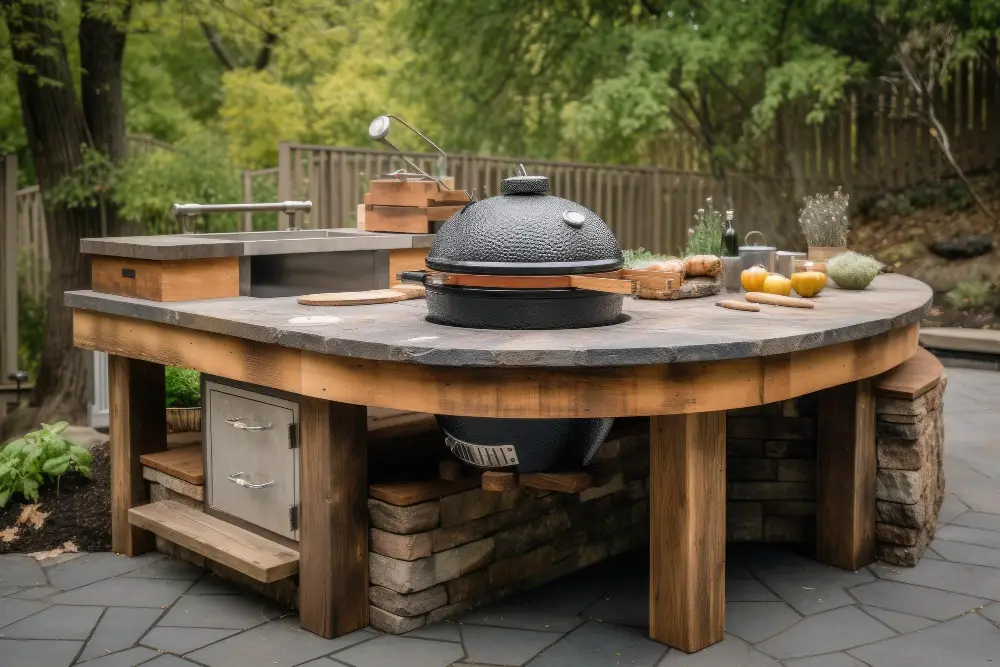
Fortunately, quartzite is a highly durable material that can withstand the harsh elements of nature. It’s incredibly hard and dense, making it resistant to scratches and chips from heavy use or accidental impacts.
Quartzite is also heat-resistant, which makes it an ideal choice for outdoor cooking areas where high temperatures are common. You won’t have to worry about hot pots or pans damaging your countertops when you choose quartzite.
Moreover, unlike other natural stones like marble or limestone that may be prone to etching due to acidic substances such as lemon juice or vinegar spills on them; Quartzite has excellent resistance against acids because of its non-porous surface.
Stain and Scratch Resistance
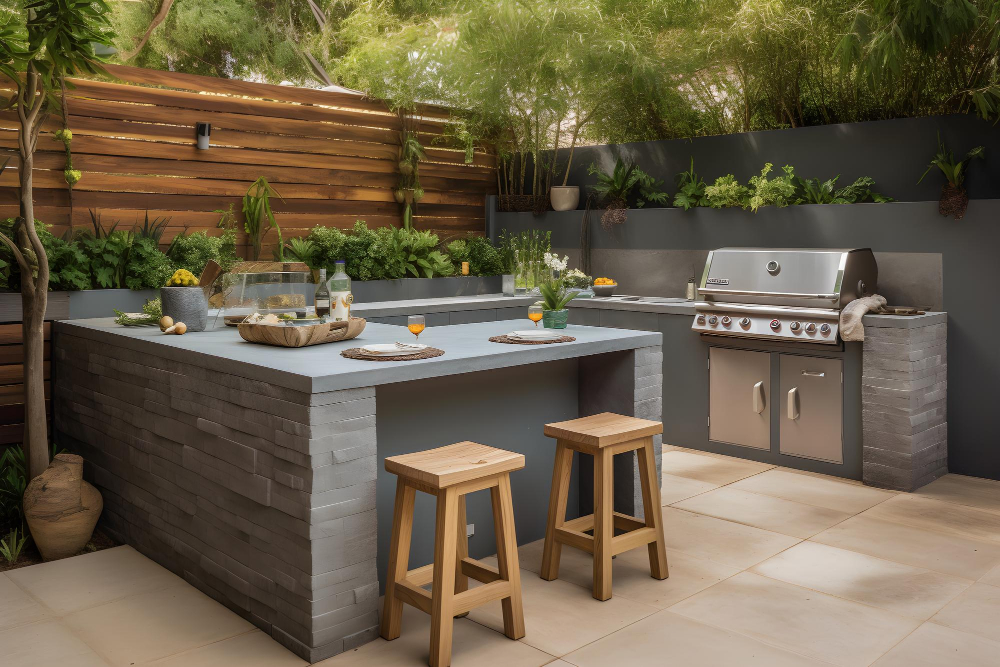
Quartzite is a natural stone that has been formed under high pressure, making it incredibly durable. It can withstand heavy use without showing signs of wear or tear, which makes it an ideal material for countertops.
Quartzite’s non-porous surface also means that it doesn’t absorb liquids easily, reducing the risk of stains from spills during cooking or entertaining guests outdoors. However, while quartzite is highly resistant to scratches and stains compared to other materials like marble or granite, you should still take care not to cut directly on its surface with sharp knives as this could cause damage over time.
Heat Resistance for Outdoor Cooking

Quartzite is known for its ability to withstand high temperatures without cracking or discoloring, making it an excellent choice for outdoor kitchens. This natural stone can handle the heat from grills and other cooking appliances without any issues.
However, while quartzite can withstand high temperatures, it’s still essential to take precautions when using hot items on your countertops. Always use trivets or hot pads under pots and pans that come directly off the stove or grill.
Avoid placing extremely hot items like pizza stones directly onto the surface of your quartzite countertop as this could cause damage over time.
Aesthetics of Quartzite Countertops
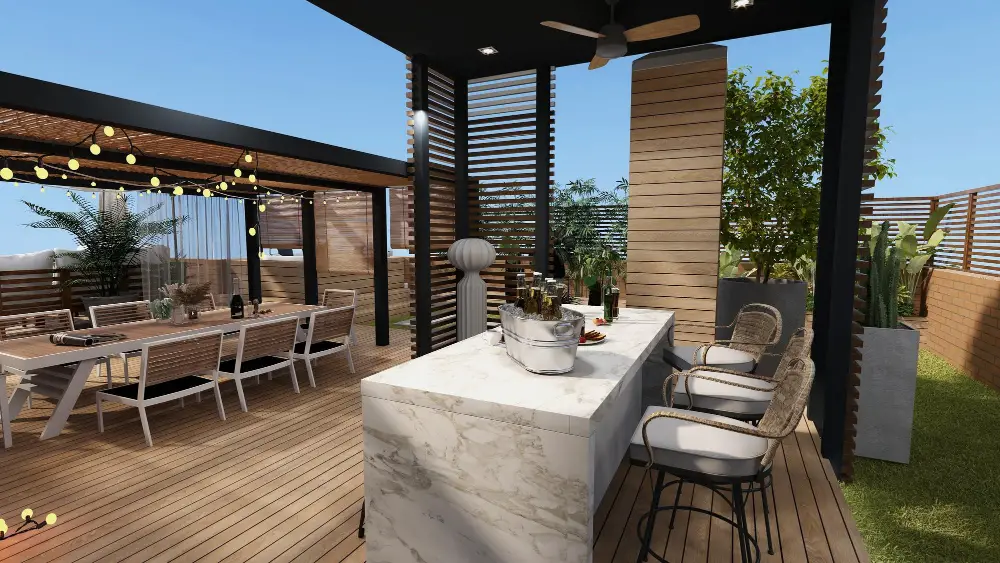
They come in a wide range of colors, from white to gray, beige to brown, and even pink or red. The veining and color variations make each slab one-of-a-kind.
One thing that sets quartzite apart from other materials is its ability to mimic the look of marble while being more durable than granite. It has an elegant appearance that can elevate any outdoor kitchen design.
When choosing quartzite for your outdoor kitchen countertops, consider the overall style you want to achieve. Do you prefer a modern look with clean lines? Or do you want something more rustic with earthy tones? With so many options available on the market today, it’s easy to find a quartzite countertop that matches your personal taste and complements your existing decor.
Quartzite Color Options

Quartzite offers a wide range of colors and patterns that can complement any design style or theme you have in mind. From classic white and gray tones to bold blues, greens, and reds, there’s a quartzite color option for every taste.
One popular choice is Taj Mahal quartzite with its creamy beige hue that adds warmth to any space. Another favorite is Sea Pearl quartzite with its soft gray background accented by subtle veins of greenish-blue hues reminiscent of ocean waves.
If you’re looking for something more dramatic, consider Fusion Blue or Azul Macaubas – both feature striking blue shades mixed with white veining creating an eye-catching statement piece in your outdoor kitchen.
It’s important to note that each slab of natural stone has unique variations in pattern and coloring due to the geological processes involved during formation. Therefore it’s recommended always seeing samples before making a final decision on which one will work best for your project.
Maintenance and Cleaning Tips
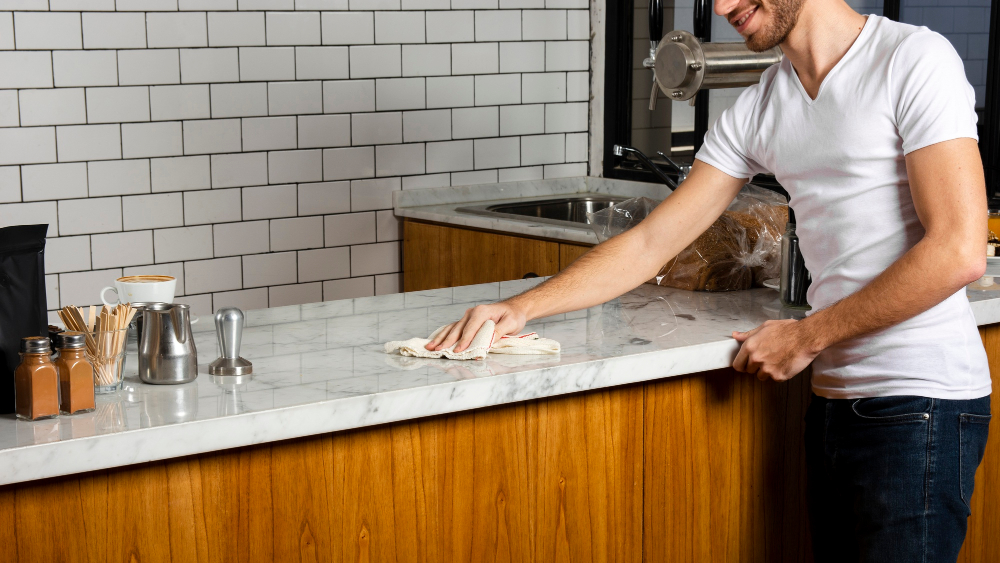
To keep your countertops looking their best, there are a few things you should do regularly.
Firstly, clean up spills as soon as possible to prevent staining. Use a soft cloth or sponge with warm water and mild soap to wipe down the surface daily.
Avoid using abrasive cleaners or scrubbers that can scratch the surface.
For tougher stains like oil or wine spills, use a mixture of baking soda and water applied directly on the stain for 30 minutes before wiping away with warm soapy water.
To avoid scratches from cutting boards or knives when preparing food outdoors on your quartzite countertop, always use cutting boards made from wood or plastic instead of metal ones.
Consider sealing your quartzite countertops every year if they are exposed to direct sunlight for long periods since UV rays can cause fading over time.
Installation Process: Crucial Steps

It’s important to note that installing quartzite countertops requires a certain level of expertise and experience. Therefore, it’s recommended that you hire a professional installer who has worked with this material before.
The first crucial step in the installation process is measuring your space accurately. This ensures that the countertop fits perfectly into place without any gaps or uneven edges.
Once measurements are taken, templates are created based on those measurements.
Next comes cutting and shaping the slabs of quartzite according to these templates using specialized tools such as diamond saws and grinders. The pieces must be cut precisely so they fit together seamlessly during installation.
After cutting, polishing follows which gives each piece its final finish while also ensuring uniformity across all surfaces used in creating your outdoor kitchen countertops made from Quartzite. Finally comes sealing which helps protect against stains caused by spills or other substances commonly found outdoors like oil or grease from cooking food outside on hot summer days!
Pricing and Affordability

The cost of quartzite can vary depending on factors such as the rarity of the stone, where it was sourced from, and its color. However, keep in mind that investing in high-quality materials for your outdoor kitchen will pay off in the long run by providing durability and longevity.
It’s important to note that while quartzite may be pricier upfront compared to other materials, it requires less maintenance over time which can save you money down the line. Choosing a reputable supplier who offers competitive pricing can help make this investment more affordable.
Eco-friendliness and Sustainability
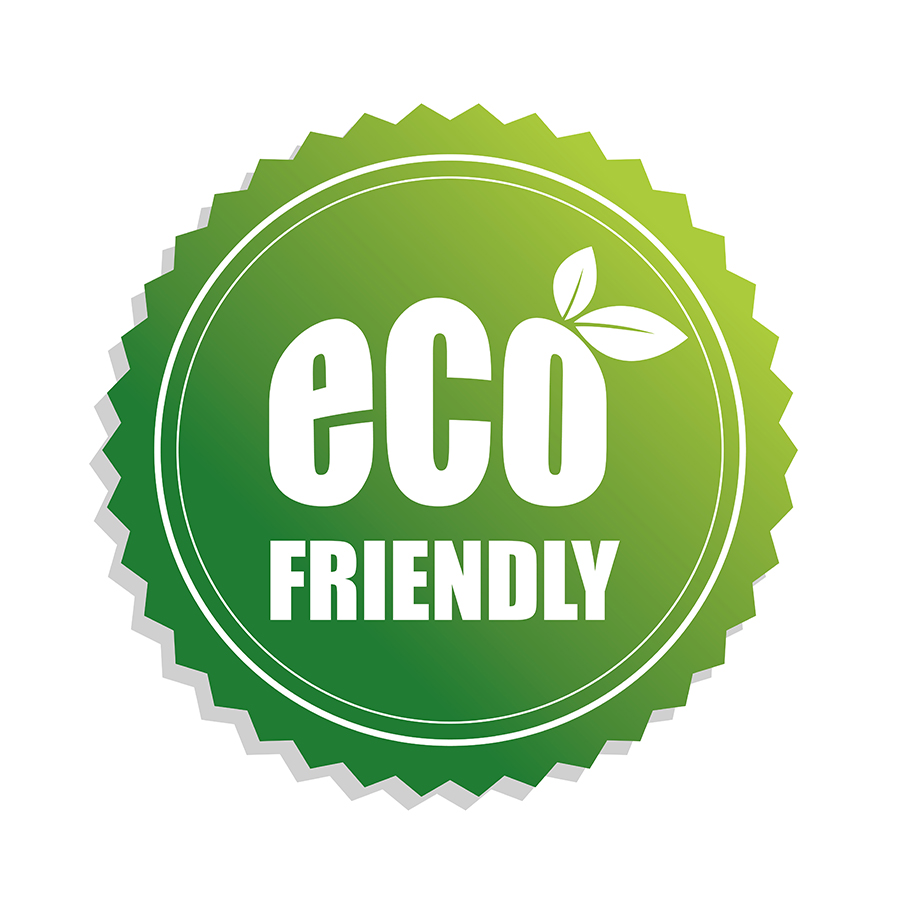
Fortunately, quartzite is a natural stone that is both sustainable and environmentally friendly. It’s made from sandstone that has been subjected to high heat and pressure over millions of years, resulting in a durable material with unique patterns and colors.
Quartzite doesn’t require any chemical treatments or sealants during the manufacturing process, making it an excellent choice for those who want to reduce their carbon footprint. Because quartzite is so durable and long-lasting when properly cared for – you won’t need to replace your countertops anytime soon – which means less waste in landfills.
Comparing Quartzite to Other Materials
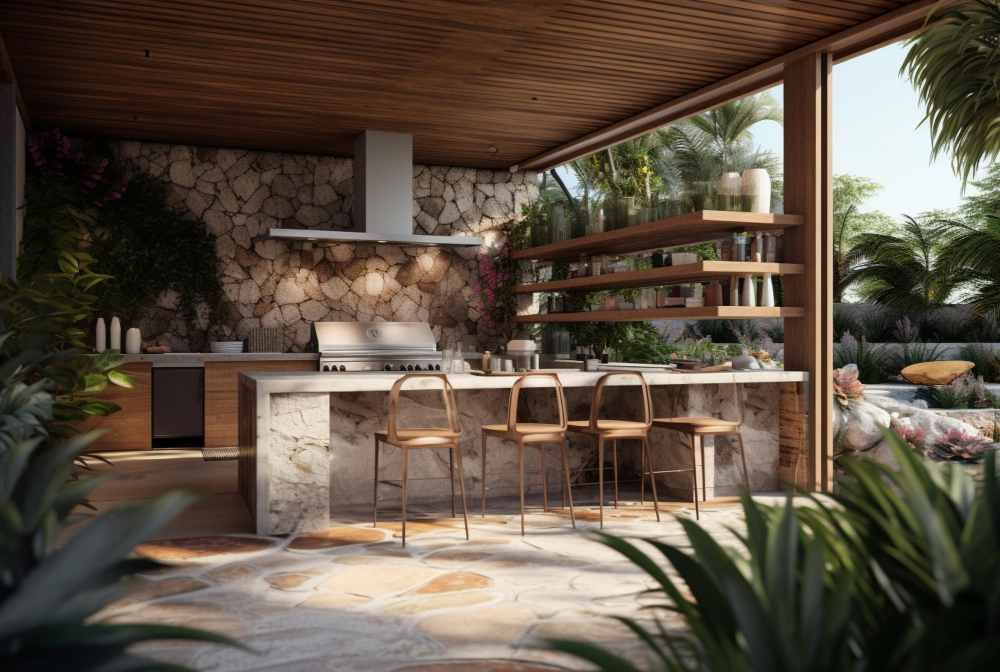
Other popular choices include granite, marble, and concrete. Each material has its own unique properties and features that make it suitable for different applications.
Granite is a natural stone that’s similar in appearance to quartzite but typically has more visible grains and patterns. It’s also slightly less durable than quartzite but still an excellent choice for outdoor kitchens.
Marble is another natural stone option with a classic look that can add elegance to any space. However, it’s not as durable or resistant to stains as other materials like granite or quartzite.
Concrete countertops are becoming increasingly popular due to their versatility and durability. They’re highly customizable in terms of color and texture but may require more maintenance than other materials over time.
Expert Opinions and Reviews

According to them, quartzite is an excellent choice for outdoor kitchen countertops due to its durability, heat resistance, and low maintenance requirements.
One expert noted that “Quartzite is one of the hardest natural stones available on earth. It’s highly resistant to scratches and stains which makes it perfect for use outdoors.” Another expert added that “Quartzites come in a wide range of colors with unique patterns making them ideal for creating stunning designs.”.
However, some experts also pointed out that while quartzite can withstand extreme weather conditions like rain or snowfall without any damage or discoloration; it may not be suitable if you live near saltwater bodies as they can cause etching over time.
Top Quartzite Brands for Outdoor Kitchens
Some of the top brands in the market include MSI, Arizona Tile, and Daltile. These companies offer high-quality quartzite that can withstand harsh weather conditions and regular use.
MSI offers a wide range of colors and patterns to choose from, making it easy to find something that matches your style preferences. Their quartzite slabs are also known for their durability and resistance against scratches.
Arizona Tile is another popular choice among homeowners looking for premium quality materials. They have an extensive collection of unique designs with varying textures that add character to any outdoor kitchen space.
Daltile’s One Quartz line features beautiful natural-looking finishes with excellent heat resistance properties perfect for cooking outdoors without worrying about damaging your countertops or surfaces.
Expert Tips for Designing Outdoor Kitchens With Quartzite
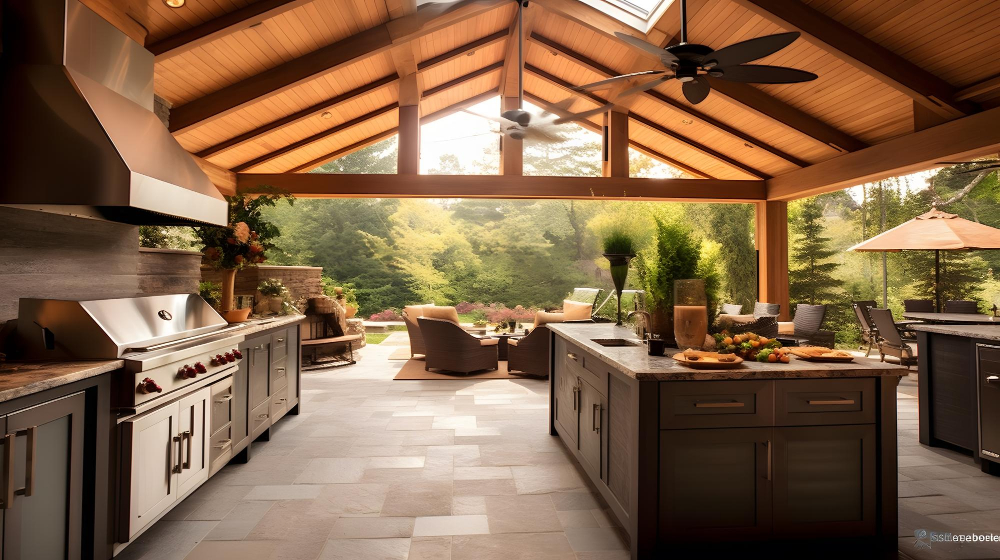
First and foremost, consider the layout of your outdoor kitchen. You want to make sure that everything is easily accessible and functional for cooking and entertaining guests.
Another important factor is choosing the right color of quartzite for your countertops. While darker colors may look sleeker, they can also absorb more heat from sunlight which could be uncomfortable during hot summer days.
Lighter shades reflect light better but might require more maintenance in terms of cleaning.
Think about incorporating other materials into your design such as stainless steel appliances or natural stone accents like slate or granite tiles on walls or floors.
Don’t forget about lighting! Proper lighting will not only enhance the ambiance but also provide safety when cooking at night.
FAQ
Is quartzite or granite better for outdoor kitchens?
Quartzite is better for outdoor kitchens due to its higher UV-resistance compared to granite, and its desirable glimmering effect when exposed to sunlight.
What is the best countertop for an outdoor kitchen?
The best countertop for an outdoor kitchen is either natural stone, concrete, or tile, as they hold up well in outdoor conditions.
What is the best stone top for outdoor kitchen?
The best stone top for an outdoor kitchen is quartzite due to its non-porous nature, resistance to staining, water damage, and scratches, as well as its ability to withstand outdoor elements.
How does quartzite hold up outside?
Quartzite holds up very well outside due to its ability to withstand extreme temperatures, rain, snow, and wind, as it is a natural product.
How does the durability of quartzite compare to other outdoor kitchen countertop materials?
Quartzite’s durability is higher compared to other outdoor kitchen countertop materials, making it an excellent choice.
What maintenance requirements should be considered for quartzite countertops in outdoor kitchens?
Quartzite countertops in outdoor kitchens require sealing periodically, prompt removal of spills, and protection from excessive heat to maintain their appearance and durability.
Are there specific quartzite finishes that are more suitable for outdoor kitchen applications?
Yes, honed and flamed quartzite finishes are more suitable for outdoor kitchen applications.
Continue reading:
